Amidst the difficulties...
At 7 a.m. Vietnam time, I contacted Dr. Tran Vu Hai - an expert from the Mekong Delta Rice Research Institute who is participating in the rice production cooperation project between Vietnam and Cuba for the period 2019 - 2025. It was 8 p.m. in Cuba at that time, and on the other end of the line, Dr. Hai gently said that this was the best time of day for us to chat because the internet would be a bit more stable.
Despite careful calculations, the call was still interrupted more than a dozen times due to weak and unstable connection, just like the slow pace of life in this Caribbean island nation.
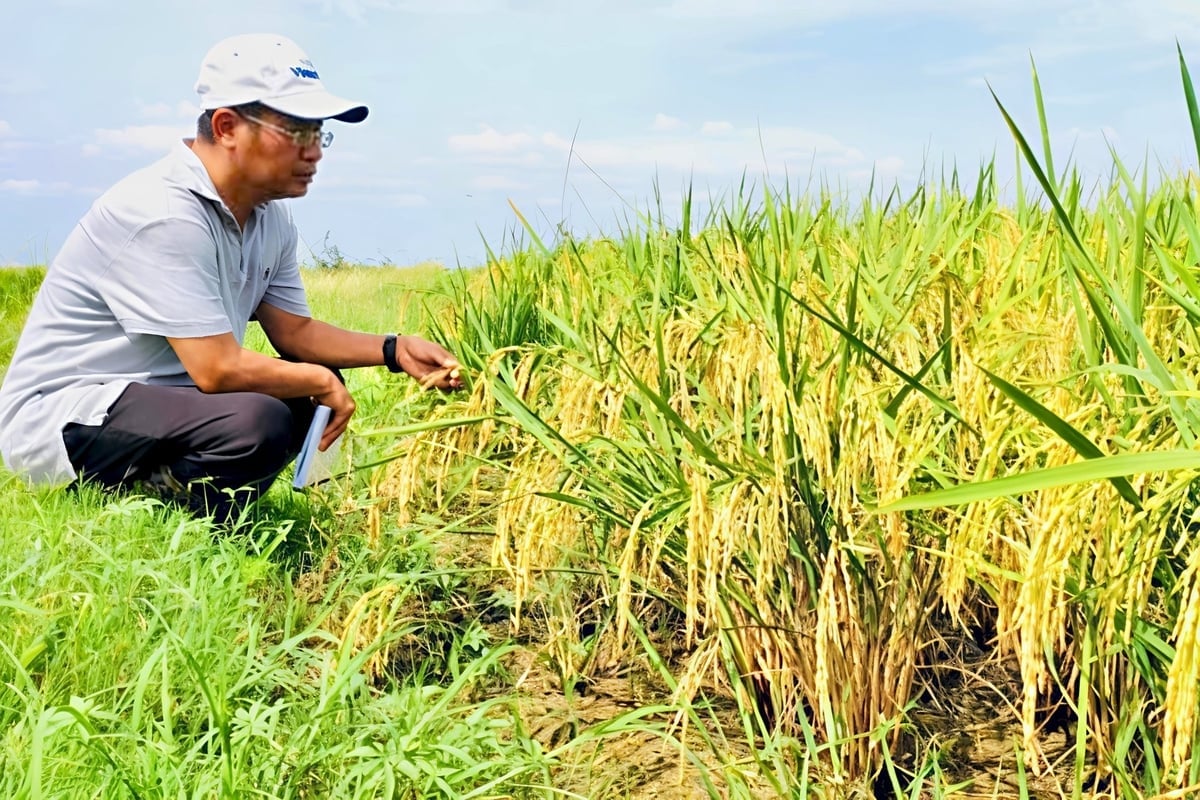
Dr. Tran Vu Hai evaluates rice yield before harvest at Matanzas (Cuba). Photo: Provided by the character.
The place where Dr. Hai lives and works is Cienfuegos province, located in southern Cuba - an arid land, sparsely populated, also a low-lying area for agricultural production. Since November 2024, he is one of three officers of the Mekong Delta Rice Institute sent to Cuba to participate in supporting the transfer of advanced rice production techniques at Matanzas, including 3 provinces: Matanzas, Cienfuegos and Mayabeque.
“The delegation has a total of 17 people participating in the project, divided into 5 locations. The capital Lahabana location has 2 officers; Pinar location has 5 officers; Sancti Spiritus location has 3 officers; Camaguey location has 4 officers and Matanzas location - where I work - has 3 people, including me, MSc. Pham The Cuong working at the North Central Institute of Agricultural Science and Technology and Mr. Nguyen Trung Thanh - Spanish interpreter”, Dr. Hai confided.
Because the main major of the staff of the Mekong Delta Rice Institute is rice, they are assigned to different locations to gain more practical experience and easily solve problems when they arise.
After nearly a year of living and working in a foreign land, Dr. Hai still clearly remembers his first impression when arriving in Cuba, which was the lack of electricity due to the limited fuel resources in Cuba. He confided that in Cienfuegos, power outages were almost “programmed”, with electricity regularly cut off for 24 hours, then people would have 5 hours to use it again, then the blackout continued.
Power outages lead to water shortages, making life and activities of the experts here difficult. Almost all members have to take advantage of every moment to charge their phones, spare batteries, rechargeable fans, and use tanks to store water.
Dr. Hai's laughter still left a trace of bitterness in me when he told the story of mosquitoes. He said that the place where he lived was also a town, with a more dense population, but he could not imagine that there were so many mosquitoes there, big and stinging terribly. Just imagine that if you wave your hand, you can catch a swarm of mosquitoes. In the dry season, it is terribly hot, making it difficult to sleep. There was even an expert in the group who was bitten by mosquitoes to the point of having an allergic reaction, scabies, and could not bear it and had to return home. Dr. Hai compared that place to the Vietnamese countryside in 1990.
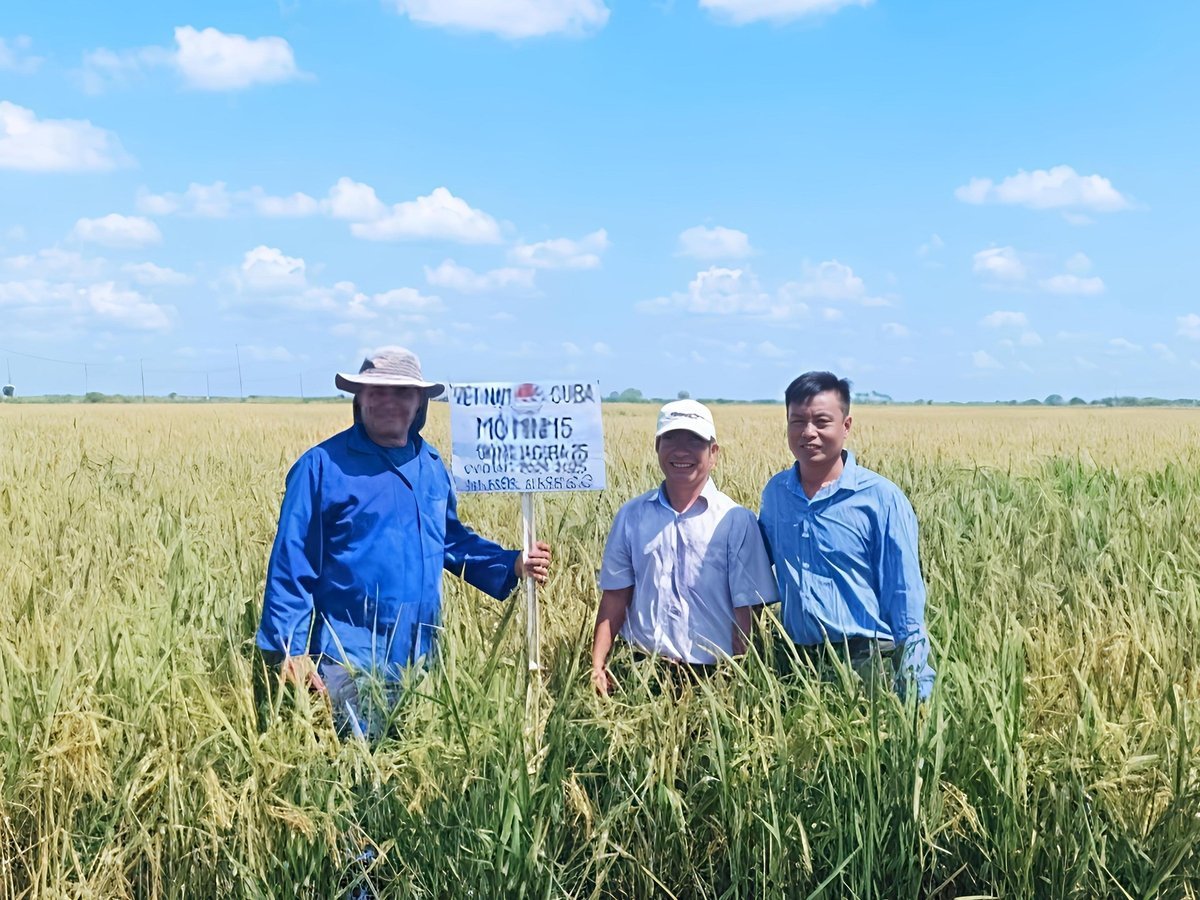
Cuban farmers' rice production conditions are still difficult. Photo: Provided by the character.
Matanzas has a very large agricultural area of about 1.1 million hectares, but due to the small population, a lot of land is abandoned. In addition to rice cultivation as the main production (about 33,500 hectares), people also grow sugarcane, peanuts, sweet potatoes, cassava... Notably, all cultivated land is owned by the state, people do not have their own land. Every month they are given ration cards to buy meat, rice, milk...
After harvest, rice is stored in local warehouses and then transferred to rice mills, then returned to the warehouses for distribution to people. The cycle of rice from harvest to use by people lasts up to a year, so the rice is no longer white but becomes damp and yellow.
“When I first came here, I asked people why they didn’t use white rice but instead ate yellow rice. They said it was because the rotation time was too long. White rice would eventually turn yellow. When the yellow rice ran out, it would be the turn of the white rice to turn yellow,” Dr. Hai recounted.
Sow knowledge, reap humanity
Overcoming difficulties, Vietnamese experts quickly integrated into the lives of local people. Instead of standing in the role of an expert, they chose to accompany the people.
Dr. Hai confided that Cuban people live very slowly, not in a hurry, they say this thing will be done today but will do it tomorrow, the day after or later, that's the way it has always been. Therefore, at first, he and his colleagues were very confused, partly due to language limitations, having to go through an interpreter, making communication with the locals very difficult. Once they got used to and understood the lifestyle of the local people, communication was no longer an obstacle.
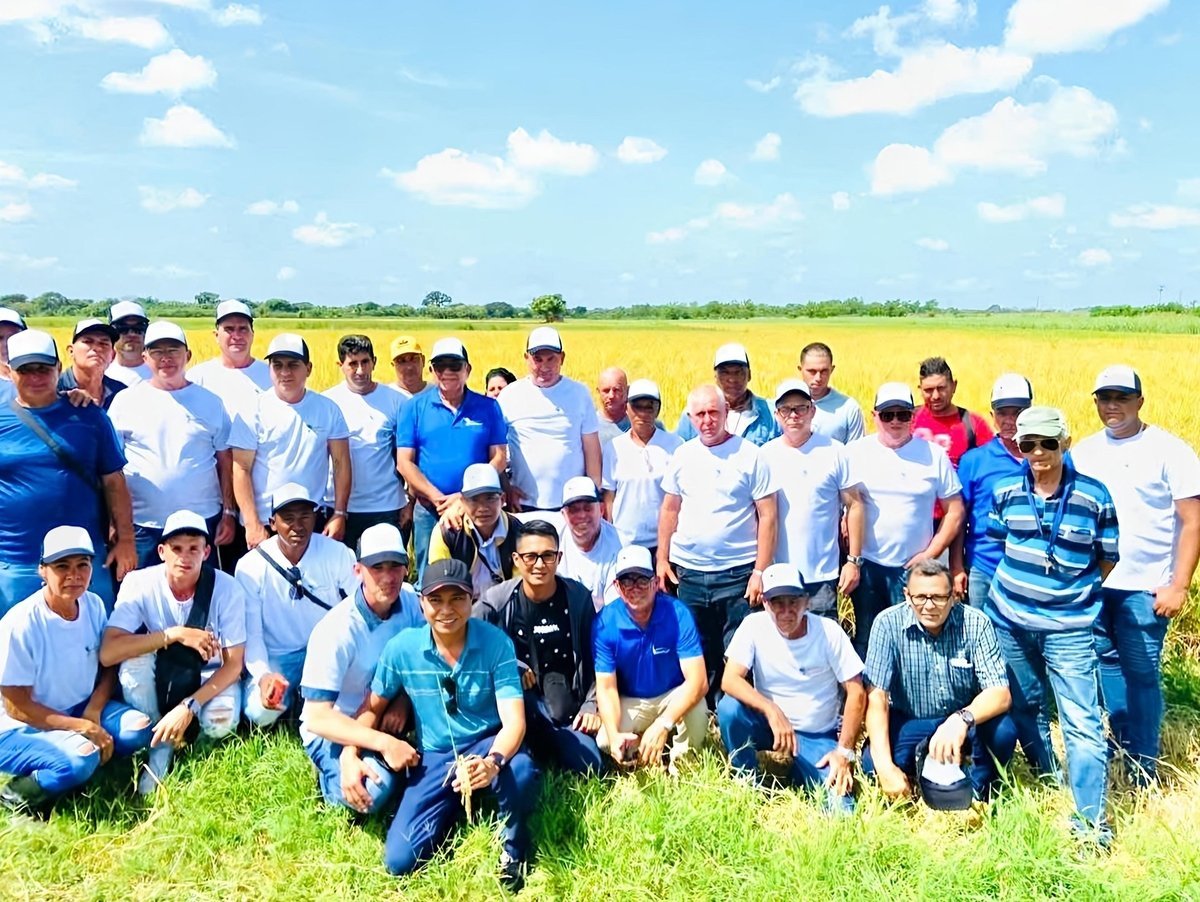
Field workshop with good farmers in Matanzas province (Cuba). Photo: Provided by the character.
“Now, when we impart techniques, people can understand 50-60%. We eat together on the edge of the field, converse in Spanish with a broken voice, but very sincerely. We share the same worries when the rice is affected by pests, and the same joy when the rice is ripe. At that time, there is no longer a gap between Vietnamese experts and Cuban farmers, but only people with the same aspiration to create golden harvests in Cuba,” Dr. Hai confided.
During a working trip with Master Pham The Cuong, the group of experts visited the farm of farmer Alexis (in the town of Aguada, Cienfuegos province). The entire field, which had been planted for only ten days, was barren and withered. Mr. Alexis was desperate, not understanding the cause. After surveying, the group of Vietnamese experts found the main culprit was the golden apple snail - a creature that seemed to be only familiar with Vietnamese rice fields but also rampant in Cuba.
“We applied snail control measures similar to those in the Mekong Delta. A week later, the entire field revived and turned green again. Mr. Alexis was moved and exclaimed: “You guys are really good, this is the first time I know this snail species is so destructive.” From then on, the villagers considered us as relatives, stopping by every day to tell stories about their fields,” Dr. Hai smiled, unable to hide his emotion at the friendliness of the Cuban farmers.
Another memory that he will always remember is the time when the team of experts was harvesting rice seeds, suddenly received news that the fields next door had been prepared but the seeds had not germinated. In Cuba, it usually takes nearly a month for people to prepare and break the dormancy of seeds before they can sow. If done the old way, the whole crop would be lost.
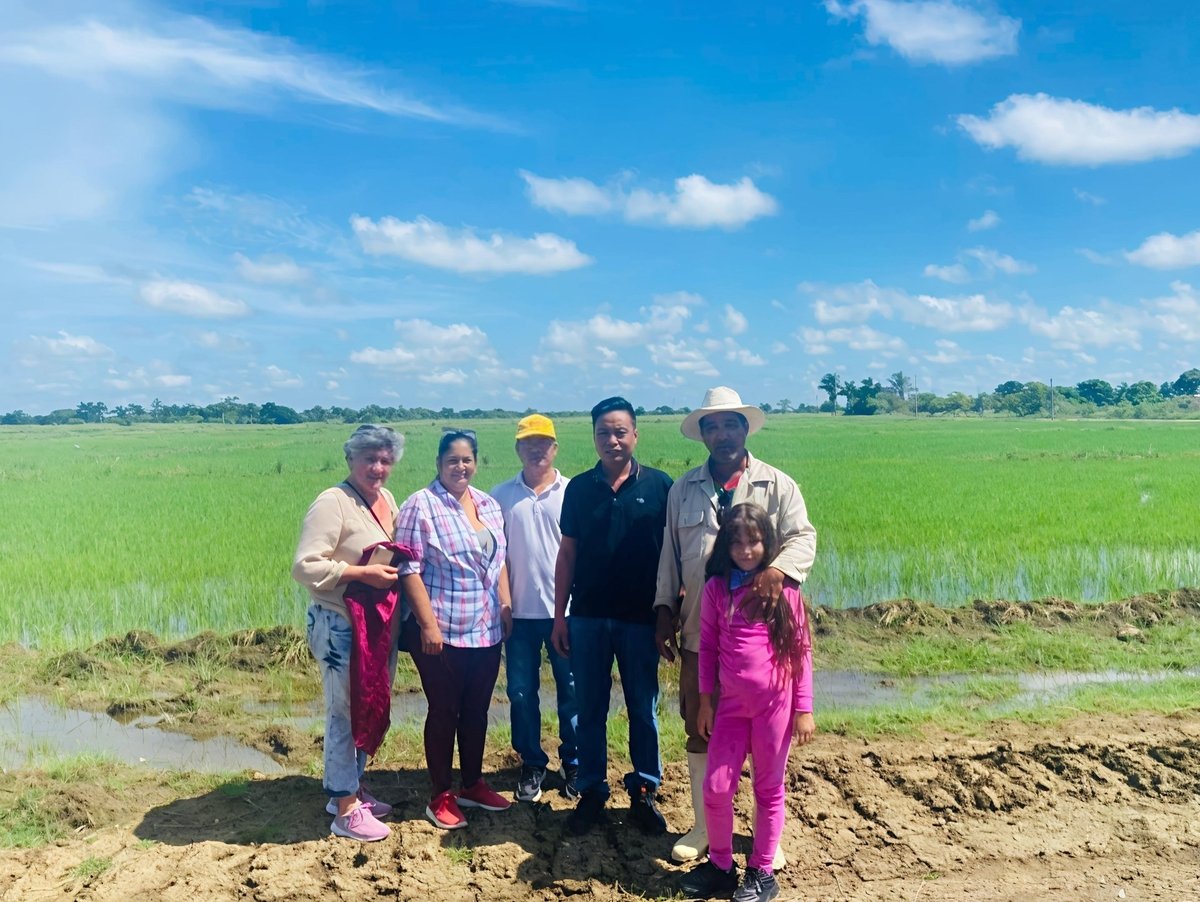
Vietnamese experts and Cuban farmers have built a strong friendship. Photo: Provided by the character.
With many years of experience, they decided to experiment with direct sowing with freshly harvested seeds, without pre-processing. It was a risky but necessary decision at that time. And surprisingly, after only one week, the whole field was covered in green. The Cuban farmers stood still, not believing what was happening before their eyes.
From an average yield of only 2 tons/ha before, models with technical support from Vietnamese experts have reached 5 tons/ha - a telling number, not only the result of science but also the result of trust and sharing.
Field of Faith
When the rice production cooperation project between Vietnam and Cuba began in 2019, Cuban farmers' rice growing techniques were still simple, mainly based on traditional experience, without much application of science and technology.
“People only dry sow, which means spreading rice seeds directly on the field so that the seeds can absorb water and germinate. People also do not know how to manage water in the field, leading to the field being dry for too long, the rice growing weeds also grow, competing with the rice plants for nutrients, causing very low productivity,” Dr. Hai shared.
This reality has urged experts to be patient and quickly guide people to gradually change their sowing methods, from soaking seeds, regulating water, and fertilizing at the right time to avoid loss.
“At first, they did not believe it, because it has been done that way for generations. We had to exchange, confide, and talk as friends. If we guided them according to the experts' methods, they would not like it and would not follow. Then, when they saw the results on their own fields, they believed a lot,” Dr. Hai excitedly recounted the initial successes of the project.
In addition, to make the technology transfer more practical and easier to understand, Dr. Hai and his colleagues often organize farmers to visit the fields to exchange experiences. Each training session and workshop must take advantage of every hour so that farmers can absorb more.
The land conditions in Cuba are naturally endowed with abundant nutrients. However, facilities, machinery, fuel, fertilizers, and pesticides are very limited, resulting in low rice productivity.
The Vietnam-Cuba rice production cooperation project will be implemented in the period 2019 - 2025, with the entire project cost covered by the Vietnamese Government . Under this project, experts will bring to the host country fertilizers, pesticides, machinery, equipment, motorbikes, etc. and then support the construction of infrastructure to improve fields, roads, bridges, and canals. The host country will respond by supporting the experts with accommodation, meals, and transportation during the working period.
In the three provinces of Matanzas, Cienfuegos and Mayabeque alone, since 2019, the project has implemented a series of effective rice production models, bringing many positive and sustainable results.
The number of fertilizations and the amount of fertilizer were reduced from 350 kg of nitrogen fertilizer/ha to 200 kg/ha. The fields were built with fixed embankments, divided into small plots to retain water and reduce loss; the rice planting season was spread evenly to reduce pressure on machinery and labor; the model of producing rice husks was also tested, helping farmers save significantly on land preparation and fertilizer costs...
In addition, nearly 1,500 technical consultation and exchange sessions were held in the fields, under the Caribbean sun and wind. Hundreds of Cuban farmers, agricultural extension officers, and producers were trained, participated in direct field practice, and were taught advanced rice production techniques. From crop management, fertilization techniques, mechanical transplanting to the timing of herbicide use, irrigation, etc., all were conveyed by Vietnamese experts with patience and enthusiasm. Those simple seminars gradually became a bridge connecting Cuban farmers with Vietnamese knowledge.
Regarding infrastructure, the project has built more than 500 km of internal roads, 528 km of canals have been renovated, 121 bridges and irrigation works have been completed, and more than 3,800 hectares of rice fields have been leveled (of which more than 3,100 hectares have been leveled using laser technology). Thanks to that, the once arid fields have gradually revived, the green water has returned to meandering around the villages, and the sounds of harvesters and plows have begun to echo in the land that seemed accustomed to silence.
The certified rice seed production model (MH3) covering over 405 hectares has contributed to raising the average rice yield of Mayabeque province to 5.59 tons/ha. Mayabeque province has become the key locality for certified rice seed production.
The demonstration model of intensive rice cultivation (MH4) on a scale of over 3,100 hectares has also contributed to raising the average rice yield to 4.7 tons/ha. Matanzas and Cienfuegos provinces have become key areas for two-crop rice production per year.
The expanded production model (MH5) with an area of nearly 13,000 hectares and an average yield of 3.61 tons/hectare is the foundation for making Matanzas province a key locality producing one rice crop per year.
Although the models are implemented on a small scale, accounting for only 1/22 of the total rice production area of the whole country of Cuba, the average yield is significantly high, 2.4 times higher than outside. This proves the superiority and replicability of the technical advances researched and tested by Vietnamese and Cuban experts.

Vietnamese experts exchange rice cultivation techniques with Cuban farmers. Photo: Provided by the character.
Cuba does not have much rice growing area, but it is here that the cooperation models between Vietnam and Cuba have become a bright spot, especially recognized by the Project Management Board and the media of the neighboring country.
More importantly, Cuban farmers have learned to trust in knowledge to confidently measure land, monitor water, take seed samples... Confidently calling each other with the still rather awkward Vietnamese titles "friend, brother, sister".
Surely, this is a memorable trip that Vietnamese experts received after completing this noble international mission.
“We will bring back a sincere and profound international friendship - a priceless gift in today's era, including the very long stories that I have not yet had time to tell you all,” Dr. Hai said sadly.
Matanzas, Cienfuegos and Mayabeque and across the Cuban fields will bear the mark of Vietnamese experts. This achievement is made of sweat in the fields, of tight hugs in the distant sun and wind.
Cuba welcomed Vietnamese friends during the most difficult years of the history of the two nations. Today, that journey continues on the “fields of friendship”.
Once, Dr. Hai stood in the middle of a field of ripe rice, the rice heads bowing to welcome the harvest. The Cuban farmers smiled brightly, held their hands tightly and exclaimed “Gracias, amigos de Vietnam” – thank you, Vietnamese friends. That was enough to dispel his fatigue, to make him understand that what they were doing in a foreign land was worthy.
Halfway around the world, Dr. Hai not only quietly sent back the project figures but also the story of reviving the sunny and windy rice fields of the Caribbean to Vietnam. That faraway place has the scent of ripe rice, the friendship and the pride of Vietnamese people who bring knowledge back as a gift to their homeland.
Source: https://nongnghiepmoitruong.vn/geo-tri-thuc-gat-mua-vang-tren-dong-dat-cuba-d780011.html








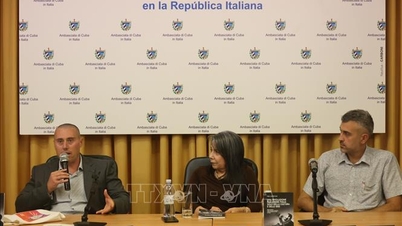




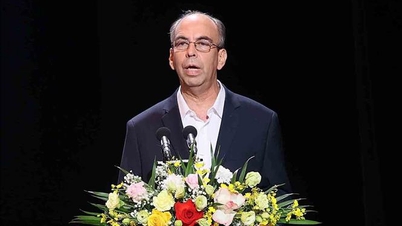




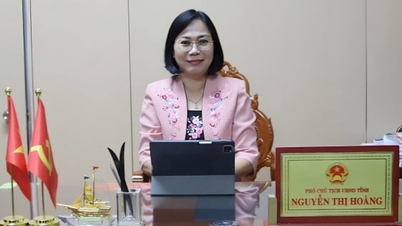
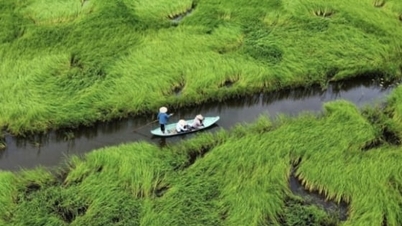








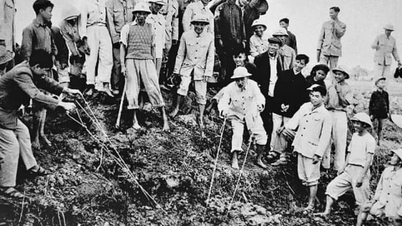


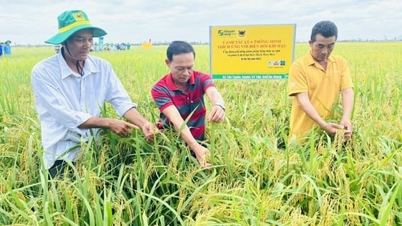
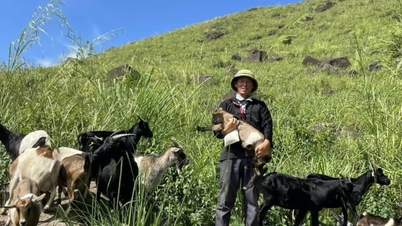






































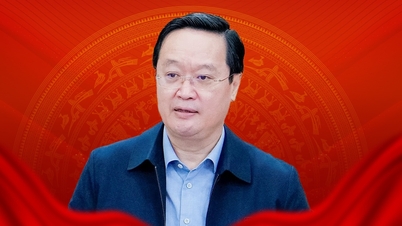




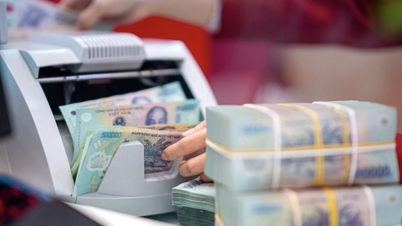
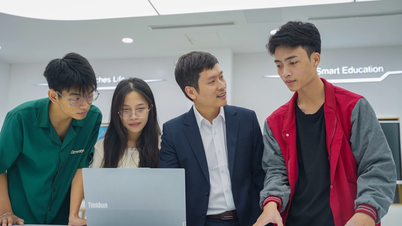








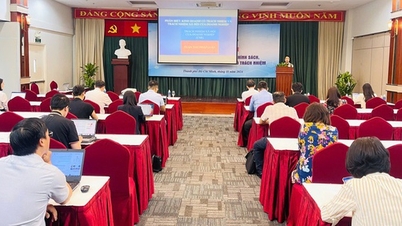







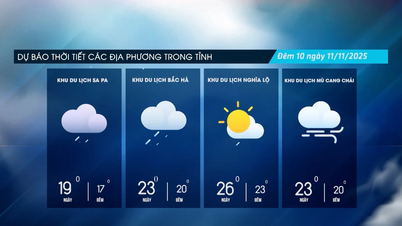




![Dong Nai OCOP transition: [Article 3] Linking tourism with OCOP product consumption](https://vphoto.vietnam.vn/thumb/402x226/vietnam/resource/IMAGE/2025/11/10/1762739199309_1324-2740-7_n-162543_981.jpeg)












Comment (0)